Abstract
Fecal samples collected from cattle at processing during a 1-year period were tested for verotoxins (VT1, VT2), Escherichia coli O157:H7, and Salmonella. Verotoxins were detected in 42.6% (95% CI, 39.8% to 45.4%), E. coli O157:H7 in 7.5% (95% CI, 6.1% to 9.1%), and Salmonella in 0.08% (95% CI, 0.004% to 0.5%) of the fecal samples. In yearling cattle, the median within-lot prevalence (percentage of positive samples within a lot) was 40% (range, 0% to 100%) for verotoxins and 0% for E. coli O157:H7 (range, 0% to 100%) and Salmonella (range, 0% to 17%). One or more fecal samples were positive for verotoxins in 80.4% (95% CI, 72.8% to 86.4%) of the lots of yearling cattle, whereas E. coli O157:H7 were detected in 33.6% (95% CI, 26.0% to 42.0%) of the lots. In cull cows, the median within-lot prevalence was 50% (range, 0% to 100%) for verotoxins and 0% (range, 0% to 100%) for E. coli O157:H7 and Salmonella (range, 0% to 0%). Verotoxins were detected in one or more fecal samples from 78.0% (95% CI, 70.4% to 84.2%) of the lots of cull cows, whereas E. coli O157:H7 were detected in only 6.0% (95% CI, 3.0% to 11.4%) of the lots of cull cows. The prevalence of verotoxins in fecal samples was lower in yearling cattle than in cull cows, whereas the prevalence of E. coli O157:H7 in fecal samples was higher in yearling cattle than in cull cows. The prevalence of E. coli O157:H7 in fecal samples was highest in the summer months. Rumen fill, body condition score, sex, type of cattle (dairy, beef), and distance travelled to the plant were not associated with the fecal prevalence of verotoxins or E. coli O157:H7. The prevalence of verotoxins in fecal samples of cull cows was associated with the source of the cattle. It was highest in cows from the auction market (52%) and farm/ranch (47%) and lowest in cows from the feedlot (31%). In rumen samples, the prevalence of verotoxins was 6.4% (95% CI, 4.2% to 9.4%), and it was 0.8% (95% CI, 0.2% to 2.3%) for E. coli O157:H7, and 0.3% (95% CI, 0.007% to 1.5%) for Salmonella.
Full text
PDF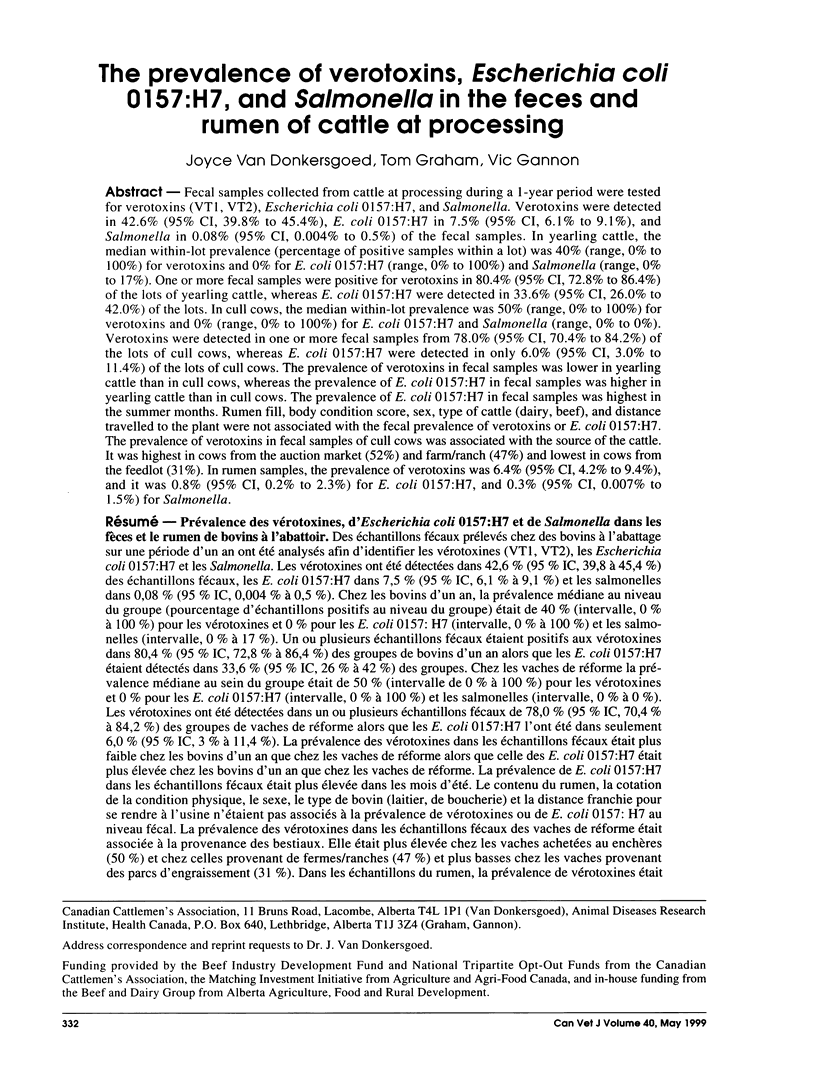
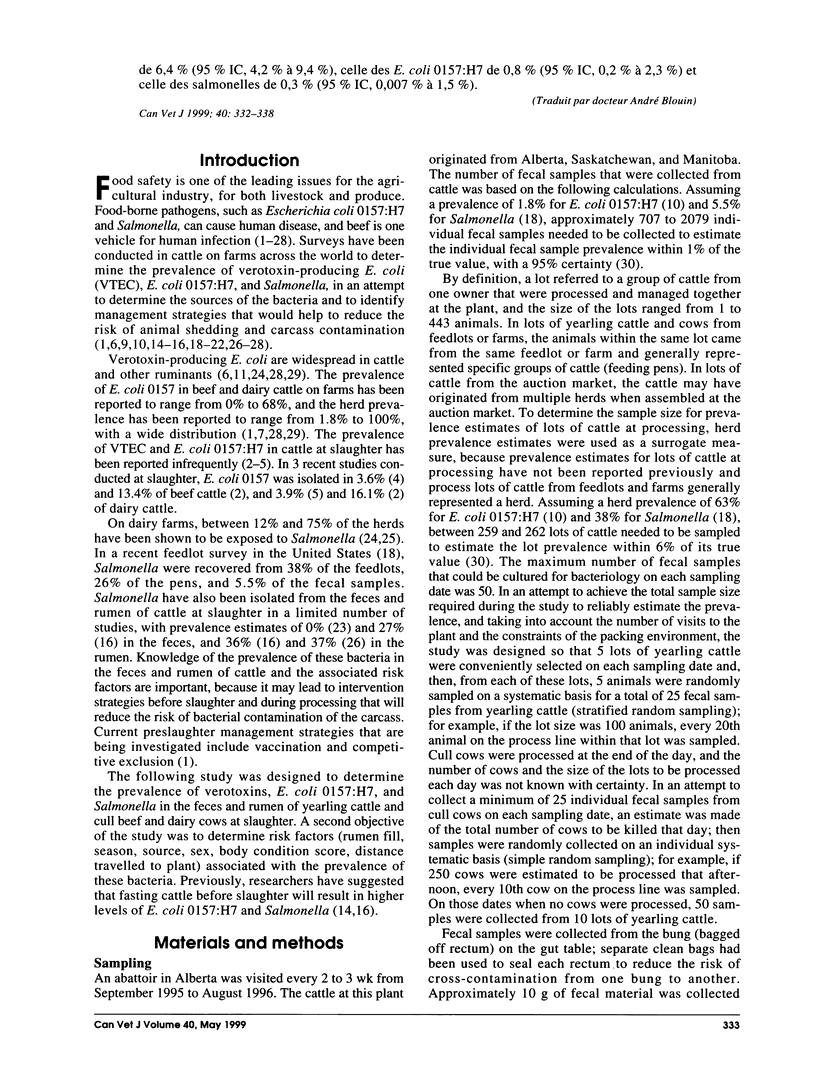
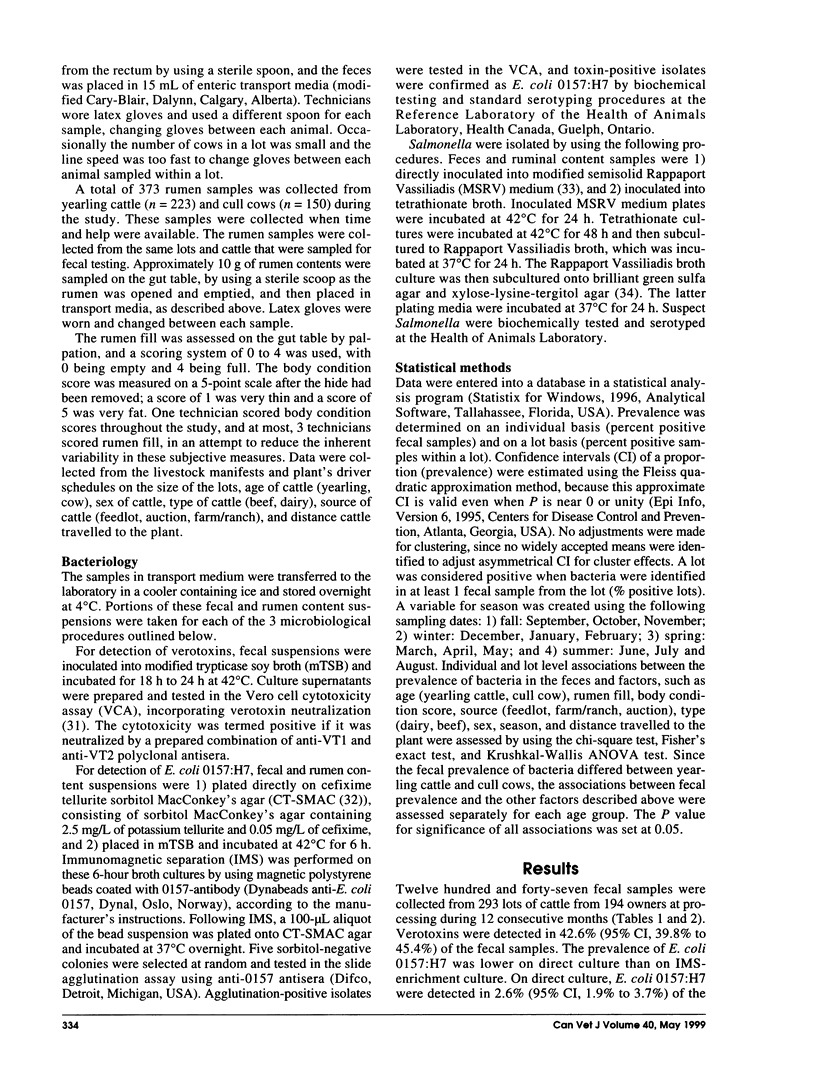
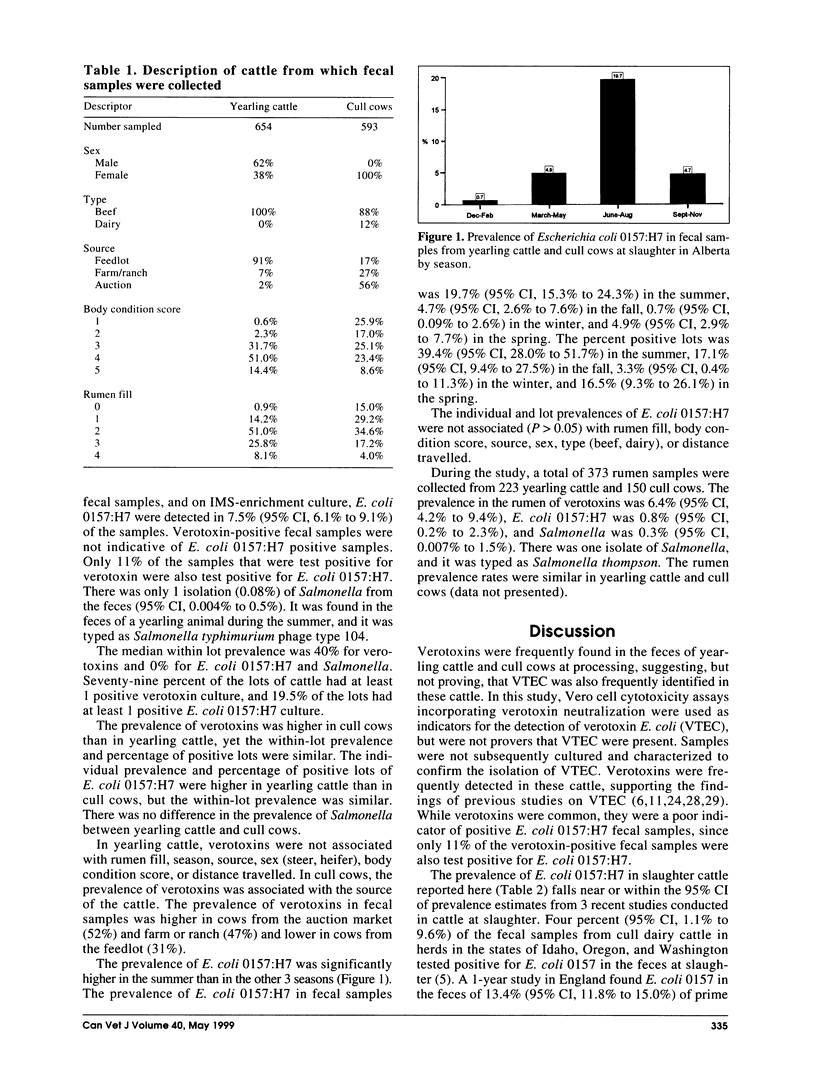
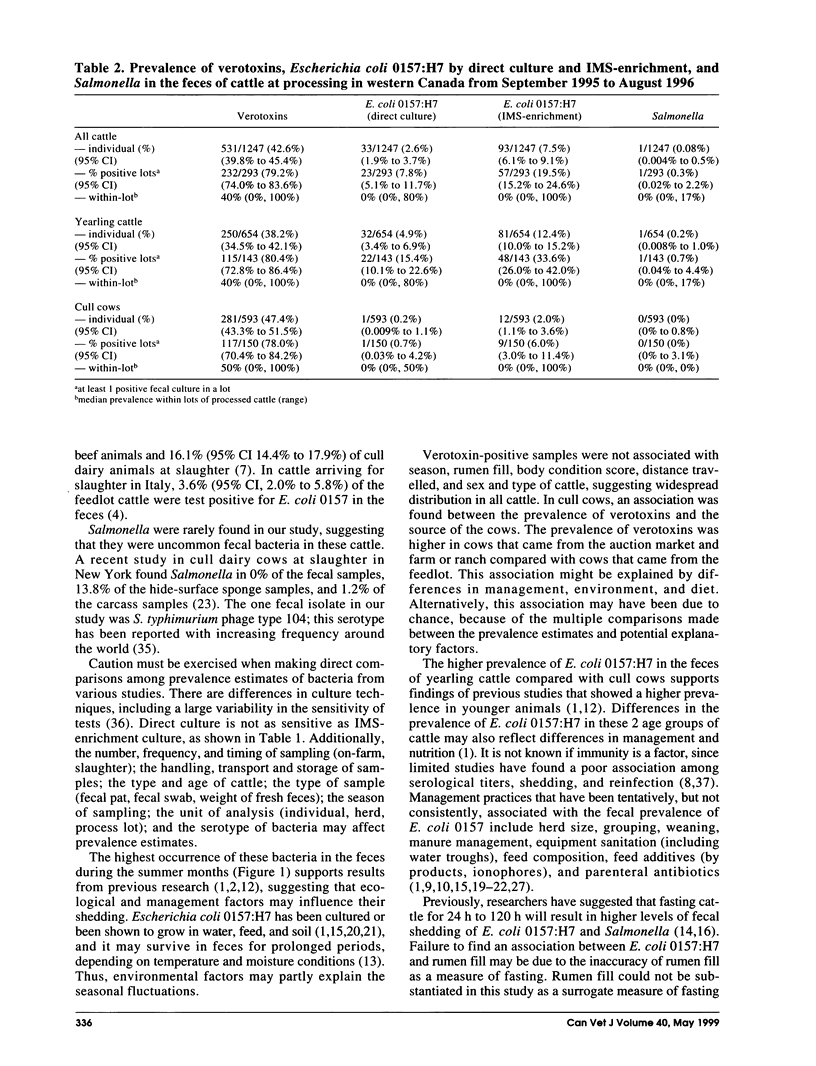
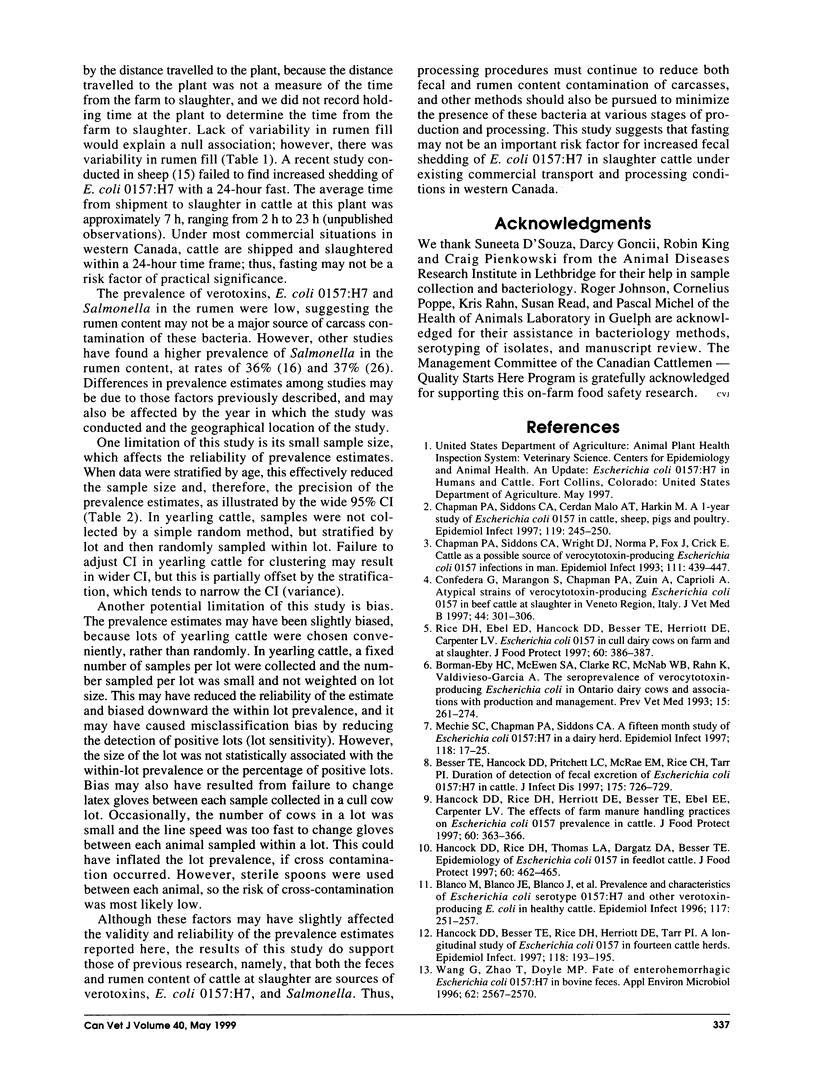
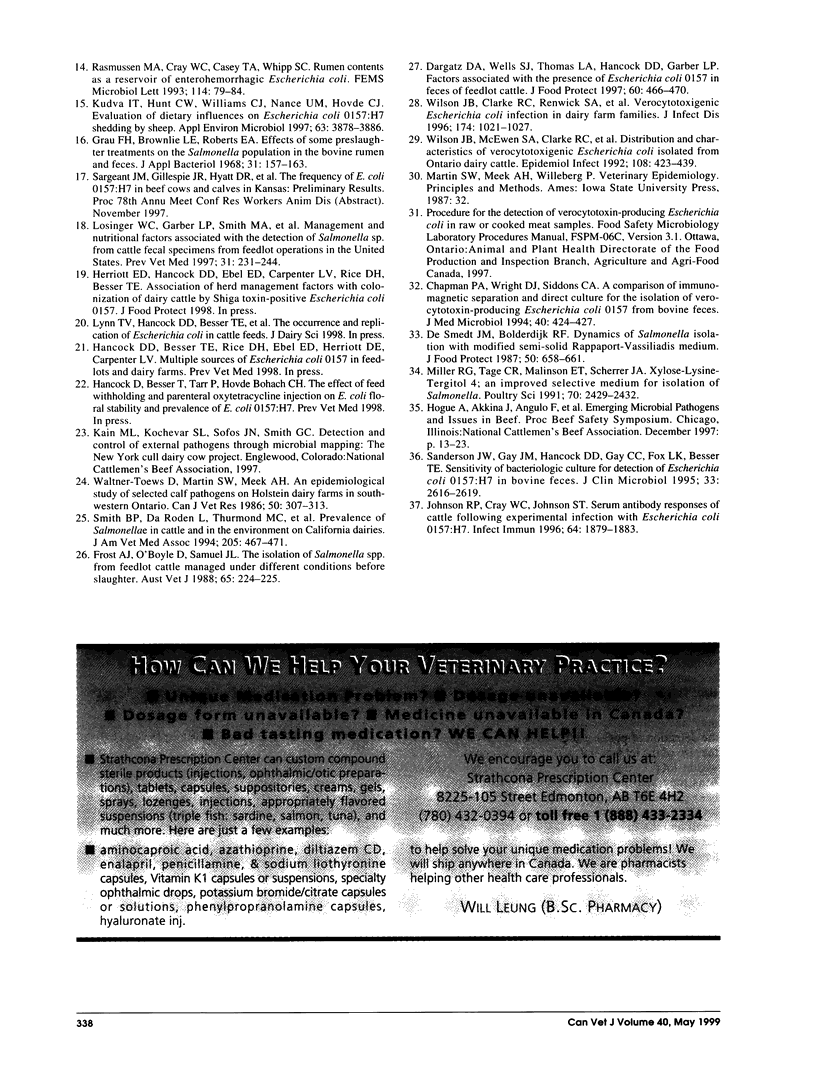
Selected References
These references are in PubMed. This may not be the complete list of references from this article.
- Besser T. E., Hancock D. D., Pritchett L. C., McRae E. M., Rice D. H., Tarr P. I. Duration of detection of fecal excretion of Escherichia coli O157:H7 in cattle. J Infect Dis. 1997 Mar;175(3):726–729. doi: 10.1093/infdis/175.3.726. [DOI] [PubMed] [Google Scholar]
- Blanco M., Blanco J. E., Blanco J., Gonzalez E. A., Mora A., Prado C., Fernández L., Rio M., Ramos J., Alonso M. P. Prevalence and characteristics of Escherichia coli serotype O157:H7 and other verotoxin-producing E. coli in healthy cattle. Epidemiol Infect. 1996 Oct;117(2):251–257. doi: 10.1017/s0950268800001424. [DOI] [PMC free article] [PubMed] [Google Scholar]
- Chapman P. A., Siddons C. A., Gerdan Malo A. T., Harkin M. A. A 1-year study of Escherichia coli O157 in cattle, sheep, pigs and poultry. Epidemiol Infect. 1997 Oct;119(2):245–250. doi: 10.1017/s0950268897007826. [DOI] [PMC free article] [PubMed] [Google Scholar]
- Chapman P. A., Siddons C. A., Wright D. J., Norman P., Fox J., Crick E. Cattle as a possible source of verocytotoxin-producing Escherichia coli O157 infections in man. Epidemiol Infect. 1993 Dec;111(3):439–447. doi: 10.1017/s0950268800057162. [DOI] [PMC free article] [PubMed] [Google Scholar]
- Chapman P. A., Wright D. J., Siddons C. A. A comparison of immunomagnetic separation and direct culture for the isolation of verocytotoxin-producing Escherichia coli O157 from bovine faeces. J Med Microbiol. 1994 Jun;40(6):424–427. doi: 10.1099/00222615-40-6-424. [DOI] [PubMed] [Google Scholar]
- Conedera G., Marangon S., Chapman P. A., Zuin A., Caprioli A. Atypical strains of verocytotoxin-producing Escherichia coli O157 in beef cattle at slaughter in Veneto region, Italy. Zentralbl Veterinarmed B. 1997 Jul;44(5):301–306. doi: 10.1111/j.1439-0450.1997.tb00977.x. [DOI] [PubMed] [Google Scholar]
- Frost A. J., O'Boyle D., Samuel J. L. The isolation of Salmonella spp from feed lot cattle managed under different conditions before slaughter. Aust Vet J. 1988 Jul;65(7):224–225. doi: 10.1111/j.1751-0813.1988.tb14464.x. [DOI] [PubMed] [Google Scholar]
- Grau F. H., Brownlie L. E., Roberts E. A. Effect of some preslaughter treatments on the Salmonella population in the bovine rumen and faeces. J Appl Bacteriol. 1968 Mar;31(1):157–163. doi: 10.1111/j.1365-2672.1968.tb00353.x. [DOI] [PubMed] [Google Scholar]
- Hancock D. D., Besser T. E., Rice D. H., Herriott D. E., Tarr P. I. A longitudinal study of Escherichia coli O157 in fourteen cattle herds. Epidemiol Infect. 1997 Apr;118(2):193–195. doi: 10.1017/s0950268896007212. [DOI] [PMC free article] [PubMed] [Google Scholar]
- Johnson R. P., Cray W. C., Jr, Johnson S. T. Serum antibody responses of cattle following experimental infection with Escherichia coli O157:H7. Infect Immun. 1996 May;64(5):1879–1883. doi: 10.1128/iai.64.5.1879-1883.1996. [DOI] [PMC free article] [PubMed] [Google Scholar]
- Kudva I. T., Hunt C. W., Williams C. J., Nance U. M., Hovde C. J. Evaluation of dietary influences on Escherichia coli O157:H7 shedding by sheep. Appl Environ Microbiol. 1997 Oct;63(10):3878–3886. doi: 10.1128/aem.63.10.3878-3886.1997. [DOI] [PMC free article] [PubMed] [Google Scholar]
- Losinger W. C., Garber L. P., Smith M. A., Hurd H. S., Biehl L. G., Fedorka-Cray P. J., Thomas L. A., Ferris K. Management and nutritional factors associated with the detection of Salmonella sp. from cattle fecal specimens from feedlot operations in the United States. Prev Vet Med. 1997 Aug;31(3-4):231–244. doi: 10.1016/s0167-5877(96)01143-9. [DOI] [PubMed] [Google Scholar]
- Mechie S. C., Chapman P. A., Siddons C. A. A fifteen month study of Escherichia coli O157:H7 in a dairy herd. Epidemiol Infect. 1997 Feb;118(1):17–25. doi: 10.1017/s0950268896007194. [DOI] [PMC free article] [PubMed] [Google Scholar]
- Miller R. G., Tate C. R., Mallinson E. T., Scherrer J. A. Xylose-lysine-tergitol 4: an improved selective agar medium for the isolation of Salmonella. Poult Sci. 1991 Dec;70(12):2429–2432. doi: 10.3382/ps.0702429. [DOI] [PubMed] [Google Scholar]
- Rasmussen M. A., Cray W. C., Jr, Casey T. A., Whipp S. C. Rumen contents as a reservoir of enterohemorrhagic Escherichia coli. FEMS Microbiol Lett. 1993 Nov 15;114(1):79–84. doi: 10.1016/0378-1097(93)90145-r. [DOI] [PubMed] [Google Scholar]
- Sanderson M. W., Gay J. M., Hancock D. D., Gay C. C., Fox L. K., Besser T. E. Sensitivity of bacteriologic culture for detection of Escherichia coli O157:H7 in bovine feces. J Clin Microbiol. 1995 Oct;33(10):2616–2619. doi: 10.1128/jcm.33.10.2616-2619.1995. [DOI] [PMC free article] [PubMed] [Google Scholar]
- Smith B. P., Da Roden L., Thurmond M. C., Dilling G. W., Konrad H., Pelton J. A., Picanso J. P. Prevalence of salmonellae in cattle and in the environment on California dairies. J Am Vet Med Assoc. 1994 Aug 1;205(3):467–471. [PubMed] [Google Scholar]
- Waltner-Toews D., Martin S. W., Meek A. H. An epidemiological study of selected calf pathogens on Holstein dairy farms in southwestern Ontario. Can J Vet Res. 1986 Jul;50(3):307–313. [PMC free article] [PubMed] [Google Scholar]
- Wilson J. B., Clarke R. C., Renwick S. A., Rahn K., Johnson R. P., Karmali M. A., Lior H., Alves D., Gyles C. L., Sandhu K. S. Vero cytotoxigenic Escherichia coli infection in dairy farm families. J Infect Dis. 1996 Nov;174(5):1021–1027. doi: 10.1093/infdis/174.5.1021. [DOI] [PubMed] [Google Scholar]
- Wilson J. B., McEwen S. A., Clarke R. C., Leslie K. E., Wilson R. A., Waltner-Toews D., Gyles C. L. Distribution and characteristics of verocytotoxigenic Escherichia coli isolated from Ontario dairy cattle. Epidemiol Infect. 1992 Jun;108(3):423–439. doi: 10.1017/s0950268800049931. [DOI] [PMC free article] [PubMed] [Google Scholar]


